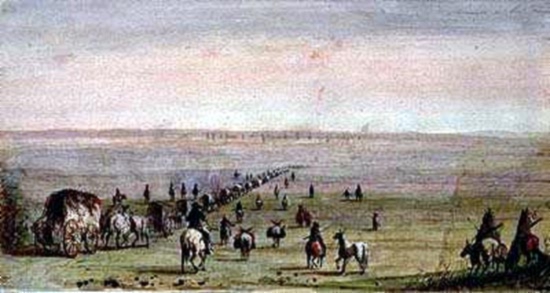
Mirage on the Prairie, Alfred Jacob Miller, 1837
The above painting depicts the Sublette and Campbell caravan heading west across the
prairies with trade goods for a rendezvous. Rendezvous were conducted in Wyoming beginning in 1825 with the first being near present
day Burnt Fort. The Rendezvous of 1833, '35, '36, '37, '39 and 1840 were held at the confluence of Horse Creek and the
Green River near present day Pinedale. Those of 1830 and 1838 on the Wind River near Riverton,
that of 1829 near Lander, and that of 1834 at Ham's Fork near
present day Kemmerer. Those of 1826, '27, '28, 31, and '32 in present day Utah or Idaho.
Rendezvous were like trade fairs at which trappers and Indians would sell to the fur companies the results of their
previous year's efforts and the companies would sell trade goods and other wares
to the trappers and Indians. During the years of the mountain men, the primary fur company was
John Jacob Astor's American Fur Company. Others were organized for short periods of time and then sold
out to another combination of traders. One of the early competitors was a partnership composed of Jedediah Smith, William Sublette, and
David Jackson which lasted four years before they sold out to Tom Firzpatrick, Jim Bridger, Milton Sublette, Henry Fraeb,
and John Baptiste Gervais, who organized the Rocky Mountain Fur Company, which in turn lasted a scant four years. In competition with both
were William Sublette and Robert Campbell organized on the basis of a three-year renewable contract. Thus, multiple
fur companies were represented at each rendezvous. At the 1832 Rendezvous at Pierre's Hole there were approximately 120 lodges of
Nez Perce, 80 of Flatheads, 90 trappers from Dripps & Fontenelle, 100 trappers from the Rocky Mountain Fur Company, 100 men from
Sublette and Campbell, assorted independent trappers, as well as a caravan from the American Fur Company. At the 1833 Rendezvous, as an example, in addition to Sublette and
Campbell, the Rocky Mountain Fur Company, the American Fur Company, and Benjamin Bonneville each set up shop.
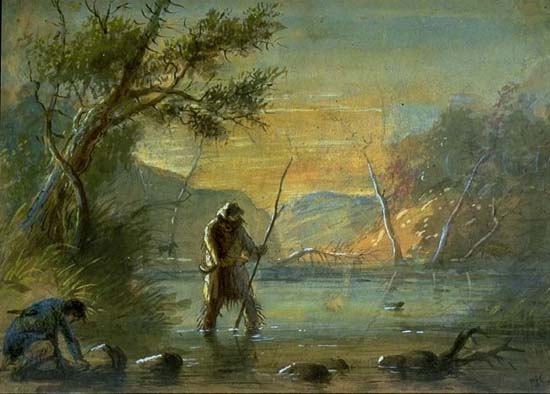
Trapping Beaver, Water Color, Alfred Jacob Miller
The trapping was primarily for the beaver underfur with which to make hats. The center of beaver
trapping was in an area which was later to become Sublette and Lincoln Counties,
Wyoming along the Green River and its tributaries. Robert Cambell in 1870 explained the process of beaver trapping:
While engaged in preparations for trapping the beaver, I will mention
some peculiar traits of that sagacious animal. The beaver has a little
bag under the tail, or more properly an oil sac near the anus.
The trapper takes this castoreum from this sac, and uses it as bait,
it having served the beaver, by providing the where-with to oil himself.
While constructing their dams, some are seen bringing sticks and bushes
for the purpose, while others dive to the bottom of the stream and bring
up mud to plaster the sticks and bushes of the structure.
They are seen near these dams and at their "lodges" on the banks of
the stream, where they ooze out this castoreum, which is understood to be
a signal to other beavers. The trappers set their traps at these places.
This castoreum, some of the old hunters use in this way. They take a piece
of willow, strip off the bark and wash it, so as to leave no scent, as the
beaver's sense of smell is exquisite, and then put castoreum on it.
The willow is attached to the trap and floats over it, when the
beaver attracted to the smell approaches and is caught. The animal
flounders about until drowned, but if he gets on the bank, with the
trap, he has been known to bite off his feet to regain his liberty.
The trappers generally set out from camp with eight traps each.
When they moved camp they cached what provisions were not necessary
for the hunt, as dependence was made on game.
Arriving at good hunting ground a stop was made of some two or
three days in a place, or even for one day.
They then set their traps for three or four miles up and down the
stream. These trappers consisted mostly of men hired in St. Louis for
eighteen months. Then there were what were called free hunters, who
lived entirely on what they killed. We seldom had any bread.
To a great extent, the fur companies raced each other to the site of the rendezvous, since the
first company to arrive had an advantage. As explained in Washington Irving's 1837 Adventures of Captain Bonneville,
a partially fictionalized account of the fur trade:
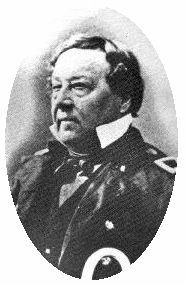
Benjamin L. E. Bonneville
The American fur companies keep no established posts beyond the mountains.
Everything there is regulated by resident partners; that is to say,
partners who reside in the tramontane country, but who move about from
place to place, either with Indian tribes, whose traffic they wish to
monopolize, or with main bodies of their own men, whom they employ in
trading and trapping. In the meantime, they detach bands, or "brigades"
as they are termed, of trappers in various directions, assigning to each
a portion of country as a hunting or trapping ground. In the months of
June and July, when there is an interval between the hunting seasons,
a general rendezvous is held, at some designated place in the mountains,
where the affairs of the past year are settled by the resident partners,
and the plans for the following year arranged.
To this rendezvous repair the various brigades of trappers from their
widely separated hunting grounds, bringing in the products of their year's
campaign. Hither also repair the Indian tribes accustomed to traffic their
peltries with the company. Bands of free trappers resort hither also, to
sell the furs they have collected; or to engage their services for the
next hunting season.
To this rendezvous the company sends annually a convoy of supplies from
its establishment on the Atlantic frontier, under the guidance of some
experienced partner or officer. On the arrival of this convoy, the
resident partner at the rendezvous depends to set all his next year's
machinery in motion.
Now as the rival companies keep a vigilant eye upon each other, and are
anxious to discover each other's plans and movements, they generally
contrive to hold their annual assemblages at no great distance apart.
An eager competition exists also between their respective convoys of
supplies, which shall first reach its place of rendezvous. For this
purpose, they set off with the first appearance of grass on the Atlantic
frontier and push with all diligence for the mountains. The company that
can first open its tempting supplies of coffee, tobacco, ammunition,
scarlet cloth, blankets, bright shawls, and glittering trinkets has the
greatest chance to get all the peltries and furs of the Indians and free
trappers, and to engage their services for the next season. It is able,
also, to fit out and dispatch its own trappers the soonest, so as to get
the start of its competitors, and to have the first dash into the hunting
and trapping grounds.
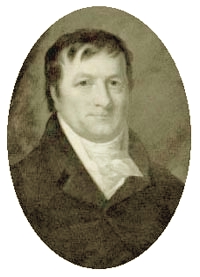
John Jacob Astor
Not withstanding the adulatory writings of Washington Irving, Bonneville had little
impact on the fur trade. French born Benjamin Louis Eulalie de Bonneville (c. 1796-1878), was a graduate of
West Point, but in 1832 took leave of absence in favor of employment by John Jacob Astor's
American Fur Company. In Wyoming, he took a train of wagons through South Pass and
estalished on the bank of the Green River near Daniel, Wyo., a trading fort known
as Fort Bonneville. Unfortunately, its location proved unsatifactory both as to
protection from the weather and its protection from the Indians. It was soon abandoned, giving rise to the
mountain men sarcastically referring to it as "Fort Nonsense." Today a monument marks its
site, but little else. During the Civil War, Bonneville served as a recruiting
officer in Missouri. At the end of the war, he was brevetted as Brigadier General. Some debate exists as to whether Fort Bonneville was an
official United States military installation. As noted, Bonneville was on a
leave of absence and ostensibly working for Astor. Because the fort was in Mexican Territory, any official installation would have been
an act of war. In all probablity, Bonneville's
expeditions were, "with a wink and a nod," at the connivance of the government for the purpose
of spying on the Mexicans and British
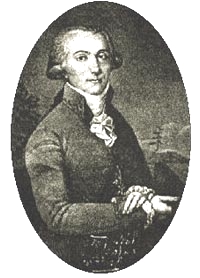
Pierre Laclede
To an extent, the fur trade in the Rocky Mountains reflected in a microcosm great national movements in the outside world.
In the popular mind the French-speaking trappers, in what was later to become
Wyoming, are associated with the Quebecois voyageurs and coureurs de bois. However, in
actuality most were from Louisiana and Missouri. Indeed, the French language continued in wde use in the Rocky Mountains. Both Chief
Washakie and Jim Bridger were fluent in French. In 1851, at the negotiations for the first Treaty of Ft. Laramie, it was still necessary
for the government to have a French interpreter present. And as the trappers moved westward out of
St. Louis and St. Charles they sang their old songs brought by their ancestors from France. One of the popular songs
amongst the trappers was, seemingly incongruous in the wilds of the Rocky Mountain West, a ditty with innumerable verses devted to the
Duke of Malbrorough, "Malbrouck s'en va-t-en guerre," the theme of which is used as background music for this page. The tune has subsequently has been used in
several classical operas and pieces including Beethoven's "Wellington's Victory,"
From 1689 to 1815, the World was locked in a series
of world-wide wars of which the French and Indian Wars, the American Revolution, the Napoleonic Wars, and the
War of 1812 were a part. Because of the French loss of what is now Nova Scotia, French-speaking Acadians settled in
Louisiana. In 1762, Louisiana, including a portion of what is now Wyoming, was transferred
to Spain. In 1800 in a secret treaty, Spain transferred Louisiana back to France in exchange for Tuscany. Spain continued, however, to administer
the territory. Napoleon recognized that he would be unable to hold on to his new territory and that it
would likely be seized by the British. Thus, there was motivation on the part of France to sell its newly regained
territory to the United States and a motivation on the part of President Jefferson to acquire the
Louisiana Territory. A British seizure of Louisiana would have left the United States isolated and hemmed in along
the Atlantic Coast surrounded by a resurgent British Empire.
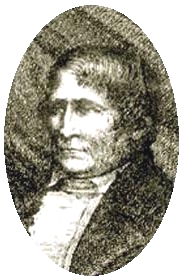
Pierre Chouteau, Sr.
With the Louisiana Purchase, American interests led by John Jacob Astor and British interests under the
Hudson's Bay Company began competing for dominance in the Pacific Northwest. And at the same time, according to
Herbert E. Bolton, "New Light on Manuel Lisa and the Spanish Fur Trade," Vol. 017, Number 1, Page 062, Southwestern Historical Quarterly Online,
the Spanish were trading "as far as northern Colorado, and perhaps into Wyoming."
At first, Astor attempted to deal with the British-owned Northwest Fur Company. The Northwest Company was formed in
1779 to compete with the Hudson's Bay Company. Gradually, the trappers for the two British companies extended their reach into the
West. While we commonly regard the Lewis and Clark expedition as the first to cross the continent, they were the
first Americans to do so. Embarking by canoe from Montreal, Alexander MacKenzie crossed the continent in 1793.
In 1802, he was the first fur trader to be knighted.
Unable to come to an
agreement with the Northwest Company, Astor looked northward towards an agreement with the Russian American Company which in 1799 had been
granted a fur trapping monoply in Alaska by the Czar. Such a pact would have put a
squeeze on the British. Astor's efforts, however, were rebuffed by the
Russian government in St. Petersburg. Nevertheless, Astor persevered. In 1809, Astor formed the
American Fur Company, chartered by the New York State Legislature with an initial capitalization of
$1,000,000 and authorization to increase the capitalization to $2,000,000. Astor's grand plan was explained by a young free-lance
writer, Edgar Allan Poe, in an 1837 review of Washington Irving's Astoria:
His scheme was gradually matured. Its main features were as follows: A line of
trading posts was to be established along the Missouri and Columbia, to the
mouth of the latter, where was to be founded the chief mart. On all the
tribuary streams throughout this immense route were to be situated inferior
posts trading directly with the Indians for their peltries. All these posts would draw upon the
mart at the Columbia for their supplies of goods, and would send thither the furs
collected. At this latter place, also, were to be built and fitted out coasting
vessels, for the purpose of trading along the North-west coast, returning with the porceeds of their
voyages to the same general rendezvous. In this manner, the whole Indian trade, both of the
coast and interior, would converge to one point. to this point, in continuation of
his plan, Mr. Astor proposed to dispatch, every year, a ship with the necessary supplies. She would
receive the peltries collected, carry them to Canton, there invest the
proceeds in merchandise, and return to New York.
With the outbreak of the
War of 1812, Astor's American Fur Company was forced to withdraw from the Pacific Coast, leaving fur trapping
in the area to the Hudson's Bay Company and to the Northwest Fur Company. Astor moved into the
area east of the Rockies along the upper Missouri. The same area was one in which French trappers from
Louisiana trapped.
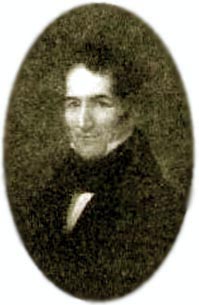
Pierre Chouteau, Jr.
In 1762, French-born Pierre Laclede (1724-1778), with Antoine Maxent, received exclusive rights
to trap along the upper Mississippi and the Missouri Rivers. Laclede is now regarded as the
founder of St. Louis. With the transfer of Louisiana to Spain, the new
Spanish government gave the exclusive rights to trade with the Osage Indians in Western Missouri to a
Spanish subject, Manuel de Lisa (1772-1820).
[Writer's note: Many sources have Lisa born in New Orleans. He was actually
born in Habana. His father was a Spanish soldier, Cristoval de Lisa. His mother was
Maria Ignacia Rodriguez, an exile from St. Augustine. In 1768, Florida was traded to
Britain in exchange for Habana, which had been captured by the British. Thus, all of the original Spanish occupants
of St. Augustine were evacuated to Cuba. Following the American Revolution when East and West Florida were returned to Spain, most of the British residents
moved to the Bahamas. Some of the original Spanish residents returned
to their old homes. Shortly after the birth of Manuel and a sister,
the family moved to New Orleans where Cristoval died. As was the custom of the day, widows not having means of support, Sra. Rodriguez in 1774
almost immediately re-married. Manuel's stepfather was Antonio Francisco Ramis, a native of Majorca. Records of the marriage were destroyed in a fire in
the cathedral on March 25, 1788. Thus, it became necessary in 1796 for Ramis to petition the Bishop
Luis Penalver y Cardenas to reestablish the certification of the marriage. This took five witnesses and the approval
of an ecclesiatical lawyer as well as the approval of the bishop. Ramis may, however, have had an "in" with the bishop; he was
the warden of the cathedral.]
Laclede's son, Pierre Chouteau, Sr., avoided Lisa's exclusive license by persuading the Osage to move
to a new territory where he could legally trade with them. [Writer's note: Laclede's marriage to
Mdm. Chouteau was not recognized by the Church. Thus, the children bore their mother's surname.] With the transfer of Louisiana to
the United States, Lisa's exclusive license expired. Thus,
Pierre Chouteau and his son Pierre Chouteau,Jr., were able to carry on the family fur business.
And at the same time, Spain's hold on Mexico crumbled. A portion of what is now Wyoming, Idaho and Utah were a part of
Mexico. Trappers also went into the Rockies out of Taos. Yet, Spain and later Mexico were powerless to
preclude American and British trappers. Forts such as Fort Bonneville were technically in
Mexican territory. Thus, the scene was set for American domination of the Rocky Mountain west.
On February 13, 1822, the following advertisement appeared in the
Missouri Gazette & Public Advertiser and two weeks later in the
St. Louis Enquirer:
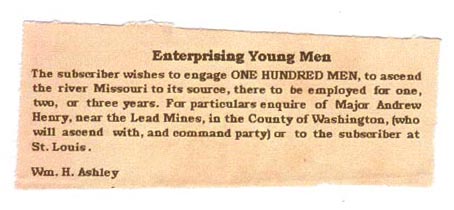
Major Andrew Henry (c. 1775-1832) had previous experience in fur trapping in
the Rockies. Henry, originally from Pennsylvania, arrived in what was to become Missouri about 1799 when it
was still under Spanish rule. He participated in an expedition on behalf
of the St. Louis Missouri Fur Company to the Three Forks of the Missouri in 1810-1811 with John Colter, wintering over on
Henry's Fork. On the Yellowstone, Manuel Lisa had established a
fort for trading with the Indians. Lisa, as a part of the formation of the new fur
company, turned the fort over to the Missouri Fur Company.
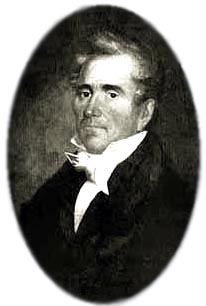 Manuel de Lisa
Manuel de Lisa
In 1812, Manuel Lisa led another
expedition to the Yellowstone. Among those participating in the expedition were
two West Point graduates, one of whom may have been an
Indian trader now known by the
name "Laramie." Both West Point graduates were later killed by
Indians.
In Wyoming, two rivers, a county, a city, a fort, a mountain peak,
and a mountain range all bear the name "Laramie." Indeed, of early
mountain men, only Jim Bridger left his name on more geographical features. Yet,
practically all sources, indicate that little is known of Laramie What is
known is in dispute, including his first name, the spelling of his last name, where he
died, or place of birth. His surname is variously spelled Laramie, LaRamie, LaRamee,
de Ramy. Generally, "Jacques," is given as his first name, although some sources have given
his first name as "Jules" or "Joseph." In most instances, information given is based on
speculation and without reference to any original sources.
French names were often spelled,
even by the literate, phonetically, accounting for some of the variations. An example
is the spelling of early fur trapper, Jean Sybille's name, variously shown in accounts as John Sibille,
John Sybille, Sibylee or Cybille. In the Lewis and Clark Journals there is great difficulty with
French names. As an example, George Drouillard, a nephew by marriage of Pierre Louis Lorimier, was spelled "Drewyer."
Lorimier, itself, was spelled variously as "Lauriesme," "Lauriesmus," and "Lauremus." In other contemporaneous records as discussed below, Lorimier
also appears as "Laramie," "Laurimier," 'Loramier," "Lorromie," or
"Loramie." Note, in the French pronunciation the final "ier" is pronounced with a "long e" and a "long a" as in the
ending for "Perrier" bottled water.
Lorimier's forename appears as Louis, Luis, Pierre, and Peter.
An 1836 map prepared by Albert Gallatin, however, may give us a suggestion as to the
identy of Laramie. The map shows rivers, lakes, and mountains which at the time would have been known only
to the early mountain men. It contains one of the first written references to a present site bearing the
name Laramie. Quite clearly, Laramie Peak is shown as "Lorimier's Peak." Other place names in
the American West, have been subject to changed spellings. Chadron, Neb. is named after
Etienne Cadran dit St. Pierre. Geary, Okla. is named after Indian trader William Guerrier. A town near the
site of Louis Lorimier's store in Ohio is named "Fort Loramie."
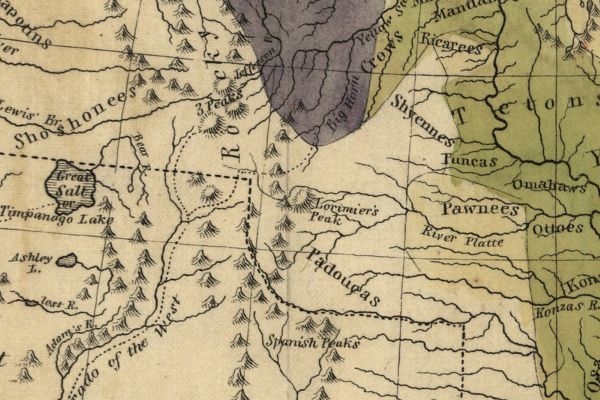
Portion of Map of the Indian Tribes of North America,
American Antiquarian Society, Transactions and Collections, Vol., 2, 1836
Courtesy of Library of Congress, Geography and Map Division.
But who was Lorimier?
Louis Houck's 1808 History of Missouri notes Indian trader Pierre Louis Lorimier (1748-1812), the founder of
Cape Giradeau, operated a trading post in Ohio referenced in the Greenville Treaty of August 3, 1895, as
"Laramie's store." The Treaty in actuality refers to the store as "Loromie's Store." The store was opened by Claude Nicholas Guillaume de Lorimier in
1769. [Writer's note, the elder Lorimier should not be confused with a Canadian military figure of
the same name who fought in the American Revolution and the
War of 1812.] The trading post was operated by the elder Lorimier, his two sons of which Louis was one, and
a nephew. During the American Revolution, Pierre Louis Lorimier remained loyal to the
Crown. In 1782, George Rogers Clark burned the store along with some $20,000.00 in trade goods.
Louis Lorimier fled the United States to Spanish territory. For services to the
Spanish Crown he was given a large land grant at Cape Girardeau. There he established a new
trading post known as the "Red House." In 1806, three years following the Louisiana Purchase, Lorimier was appointed as
Indian Agent. In addition to being fluent in English, Spanish, and French, Lorimire reputedly
spoke some twenty-two Indian languages. Lorimier
was married three times. His first two wives,
Shawnee Woman and Charlotte Pemanpich Bougainville, were
mixed-blood Shawnees. Thus, his children were mixed blood, 1/4 or 1/2 Shawnee. There were at
least eight children. His 1808 last will and testament lists six.
Two children, Louis, Jr., born 1784, and Auguste Bougainville de Lorimier,
born 1790, received
appointments to West Point. Concern, however, was expressed by a government agent to President
Jefferson that Louis, Jr. "exhibited too
much of the Indian in his color" and would, thus, be harassed by his fellow cadets. Louis, Jr. graduated and
was commissioned as an ensign in the Second Infantry in 1806 and receiving a promotion to
second lieutenant in the 1st Infantry Regiment in 1808. (See Senate Executive Journals, 2/25/1807,
4/23/1808, 4/30/1810.}
Auguste did not
graduate.
In the army, Louis, Jr. served at St. Louis and
at Fort Osage. Following his resignation from the Army in December 1809, Louis Jr., as did his father before him,
engaged in the Indian Trading business. It may therefore be assumed that Louis Jr. was like his
father fluent in Indian languages. Louis Senior's estate was substantial, the
executors' bond was set at $20,000.00.
Manuel Lisa's list,
La Compagny des fourures du Missoury dans unf adveure conduit par Manuel Lisa dans deux barge partits
l'une le 2 May et l'autre le 6, 1812,
Kansas State Historical Society, of those on the 1812 expedition include
Louis Lorimier and another former Army officer originally from
Pennslvania, Michael E. Immel. Immel [in military
records spelled "Immell"] also
had previously worked as a free trapper and participated in the 1810-11 expedition. The fur company's clerk, John C. Luttig's log of the
expedition, later published as The Journal of a Fur-Trading Expedition on the
Upper Missouri, 1812-1813, indicates that on several ocassions
Lorimier and Immel worked together in trading with Indians. This indicates the familiarity of both
Lormimer and Immel with Indian languages and trade. Immel remained with
the Missouri Fur Company and was killed by
Indians in 1823 in the Yellowstone Valley. The attack on Immel's brigade became an international incident. The
Indians were armed with British rifles. The furs stolen from the brigade found their way
into the hands of the Hudson's Bay Company. The Hudson's Bay Company was ultimately censured by the British
government.
West Point biographical information indicates that Louis Lorimier was killed by Indians. The date and location
is uncertain. The Academy today claims that Lorimier was the first native American to graduate from
the Acadamy. West Point references as well as President Jefferson's nomination for
commission and President Madison's notice of Loramier's resignation spell the name as "Loramier." It is popularly regarded that he
disappeared while beaver trapping along a tributary of the Platte.
Jim Bridger in 1868 told John Hunton that Bridger had been a part of an
1821 search party which found only a half completed cabin and a broken beaver trap. Bridger indicated that
two years later he was told by the Arapaho that they had killed Laramie and
placed his body under the ice behind a beaver dam. The difficulty with Bridger's account, at
least as to the date, was that Bridger did not join Ashley's company until 1822. In 1821, Bridger was
a ferryman in Missouri. Bridger was with the Ashley expedition until 1824. Thus, the event could
not have occurred when indicated. This, however, may be forgiven in that the
story was told to Hunton some 40 years after the fact.
In addition to Henry and
Lisa, other principals of the Missouri Fur Company included Pierre Chouteau, Sr. who by then was able to put his
disagreements with Lisa aside. But at the same time according to Bolton, Lisa was
communicating with Spanish authorities in Mexico about his activities along the
Yellowstone. The lead mines mentioned in the advertisement were near Potosi, southwest of St. Louis. During the War of 1812, Henry served
as a major in the Missouri Militia. Under him, serving as an ensign, was Stephen F. Austin, "The Father of Texas" and later Secretary of
State of the Republic of Texas. Over Henry was William H. Ashley.
Ashley (1778-1838) had made his initial fortune as the owner of a gunpowder plant. The plant had a disconcerting
habit of blowing up. The problem was solved by putting the walls on hinges. Following statehood,
Ashley served as Lt. Governor of Missouri.
Music this page courtesy Le cowboy de Crique de Cheval:
Malbrouck s'en va-t-en guerre
(Marlborough Has Gone to War)
Malbrouck s'en va-t-en guerre,
Mironton, tonton, mirontaine;
Malbrough s'en va-t-en guerre,
Ne sait quand reviendra... (ter)
Il reviendra z'à Pâques,
Mironton, tonton, mirontaine;
Il reviendra z'à Pâques,
Ou à la Trinité. (ter)
La Trinité se passe,
Mironton, tonton, mirontaine;
La Trinité se passe,
Malbrough ne revient pas. (ter)
Madame à sa tour monte,
Mironton, tonton, mirontaine;
Madame à sa tour monte,
Si haut qu'ell' peut monter. (ter)
Elle aperçoit son page,
Mironton, tonton, mirontaine;
Elle aperçoit son page,
Tout de noir habillé. (ter)
Beau page ! Ah ! Mon beau page,
Mironton, tonton, mirontaine;
Beau page ! Ah ! Mon beau page,
Quelle nouvelle apportez? (ter)
Aux nouvell's que j'apporte,
Mironton, tonton, mirontaine;
Aux nouvell's que j'apporte,
Vos beaux yeux vont pleurer. (ter)
Quittez vos habits roses,
Mironton, tonton, mirontaine;
Quittez vos habits roses,
Et vos satins brochés. (ter)
Monsieur d'Malbrough est mort,
Mironton, tonton, mirontaine;
Monsieur d'Malbrough est mort,
Est mort et enterré. (ter)
J'l'ai vu porté en terre,
Mironton, tonton, mirontaine;
J'l'ai vu porté en terre,
Par quatre z'officiers. (ter)
L'un portait sa cuirasse,
Mironton, tonton, mirontaine;
L'un portait sa cuirasse,
L'autre son bouclier. (ter)
|
L'un portait son grand sabre,
Mironton, tonton, mirontaine;
L'un portait son grand sabre,
L'autre ne portait rien. (ter)
A l'entour de sa tombe,
Mironton, tonton, mirontaine;
A l'entour de sa tombe
Romarin l'on planta. (ter)
Sur la plus haute branche,
Mironton, tonton, mirontaine;
Sur la plus haute branche,
Le rossignol chanta. (ter)
On vit voler son âme,
Mironton, tonton, mirontaine;
On vit voler son âme,
A travers les lauriers. (ter)
Chacun mit ventre à terre,
Mironton, tonton, mirontaine;
Chacun mit ventre à terre,
Et puis se releva. (ter)
Pour chanter les victoires,
Mironton, tonton, mirontaine;
Pour chanter les victoires,
Que Malbrough remporta. (ter)
La cérémonie faite,
Mironton, tonton, mirontaine;
La cérémonie faite,
Chacun s'en fut coucher.(ter)
Les uns avec leurs femmes,
Mironton, tonton, mirontaine;
Les uns avec leurs femmes,
Et les autres tout seuls. (ter)
Ce n'est pas qu'il en manque,
Mironton, tonton, mirontaine;
Ce n'est pas qu'il en manque,
Car j'en connais beaucoup. (ter)
Des blondes et des brunes,
Mironton, tonton, mirontaine;
Des blondes et des brunes,
Et des châtains aussi. (ter)
J'n'en dis pas davantage,
Mironton, tonton, mirontaine;
J'n'en dis pas davantage,
Car en voilà assez.
|
A much shorter version was later penned by Longfellow:
Marlborough the Prince of Commanders
Is gone to war in Flanders,
His fame is like Alexander's,
But when will he ever come home?
Mironton, mironton, mirontaine.
Perhaps at Trinity Feast, or
Perhaps he may come at Easter,
Egad! he had better make haste or
We fear he may never come home.
Mironton etc.
For Trinity Feast is over,
And has brought no news from Dover,
And Easter is pass'd moreover,
And Malbrook still delays.
Mironton etc.
Milady in her watch-tower
Spends many a pensive hour,
Not knowing why or how her
Dear lord from England stays.
Mironton etc.
While sitting quite forlorn in
That tower, she spies returning
A page clad in deep mourning,
With fainting steps and slow.
Mironton etc.
"O page, prithee come faster!
What news do you bring of your master?
I fear there is some disaster,
Your looks are so full of woe.
"
Mironton etc.
|
"The news I bring fair lady,"
With sorrowful accent said he,
"Is one you are not ready
So soon, alas! to hear.
Mironton etc.
"But since to speak I'm hurried,"
Added this page, quite flurried,
"Malbrook is dead and buried!"
And here he shed a tear.
Mironton etc.
"He's dead! He's dead as a herring!
For I beheld his berring,
And four officers transferring
His corpse away from the field.
Mironton etc.
"One officer carried his sabre,
And he carried it not without labour,
Much envying his next neighbour,
Who only bore a shield.
Mironton etc.
"The third was helmet bearer -
That helmet which in its wearer
Fill'd all who saw it with terror,
And cover'd a hero's brains.
Mironton etc.
"Now, having got so far, I
Find that - by the Lord Harry!-
The fourth is left nothing to carry.-
So there the thing remains."
Mironton, mironton, mirontaine.
|
If the gentle reader does not recognize the tune it is now the basis for a
children's song.
Next page: The Fur Trade Continued.
|